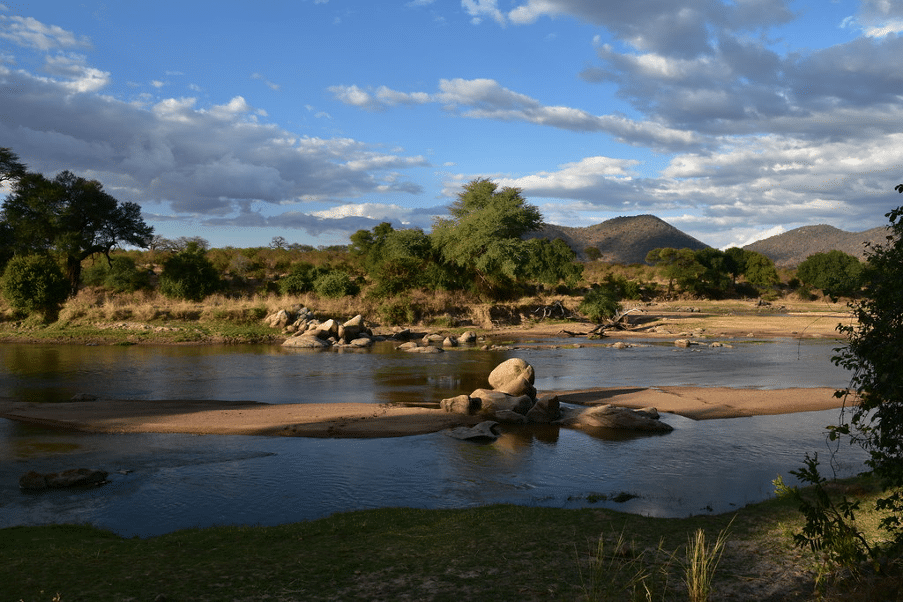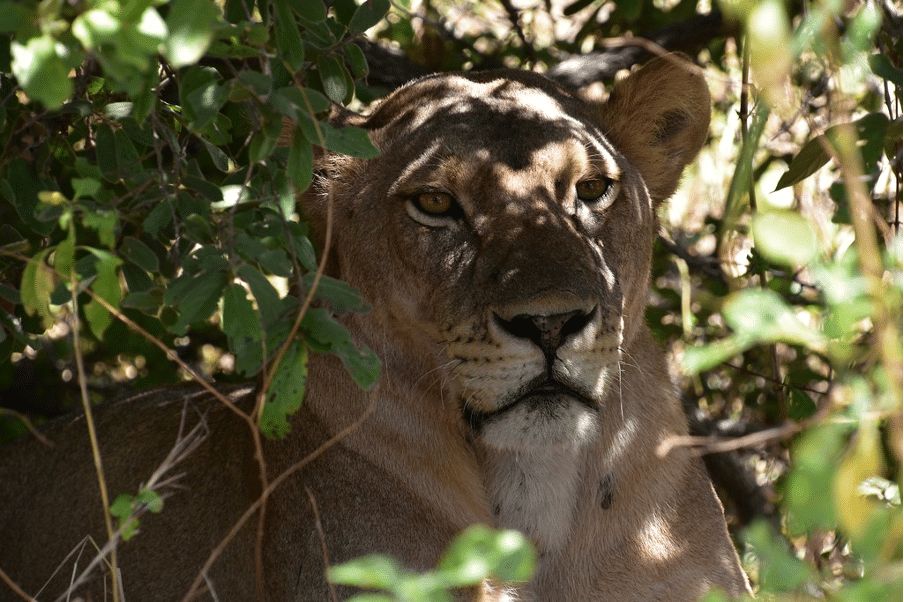About
Top Experiences
Type of Journey
Subscribe to newsletter and stay updated
Read about our travel expeditions, new destinations, new pictures, latest trip schedules
Located in the heart of Tanzania is the Ruaha National Park, measuring 12,226 square kilometers. The pristine and untouched Ruaha is the largest national park in the country. It is bordered by the Kizigo, Muhesi, and the Rungwa Game Reserves in the north, forming the 45,000 square kilometers of the Rungwa-Kizigo-Muhesi ecosystem. The Mbomipa-Wildlife Management Area is also part of Ruaha National Park.
Ruaha’s secluded location attracts fewer tourists than any other park in the northern circuit, making safaris intimate and unique. This wild landscape encompasses rocky escarpments, baobab studded hills, acacia, and miombo forests as well as a diverse species of wildlife. The park is crossed by the Great Rift Valley, creating a spectacular scenery. The Great Ruaha River is the main highlight of the park, acting as the prime water source for various animals.
Ruaha is a wildlife enthusiasts’ haven as it has exciting game action. Along with having a healthy population of elephants and buffalos, Ruaha is home to ten percent of the world’s lion population and one of four cheetah populations found in East Africa. It also houses third-largest wild dog population in the world. This remote park combined with a great diversity of wildlife creates a rewarding safari experience.

OVERVIEW
Location: Tanzania
Nearest airport: Msembe airstrip, Jongomeru airstrip, within the park. Dar-es-salaam is nearest intl. airport.
How to reach: From Dar es Salaam by road or flight
Famous for: predator population, herds of elephants, African wild dogs, game drives, birding, Great Ruaha River
Months open : All year
Best time to visit : June to October
WHAT TO SEE
African wild dogs
Elephant population
Predator population
Over 500 bird species
Great Ruaha River
Great Rift valley
The Ruaha National Park was once home to the Wahehe people. In 1910, the Saba River Game Reserve was created by the German colonial administration. In the late 1940s, it was re-gazetted or renamed as Rungwa Game Reserve by the Britishers after Germany was defeated in World war I. In 1964, Rungwa was again re-named officially as Ruaha National Park, deriving its name from Ruaha River. In the local Hehe language, Ruaha translates to ‘river’. The name was changed after Tanganyika (now known as Tanzania) got its independence from Britain. The addition of the Usangu Game Reserve and other wetlands in 2008 extended the park to around 20,226 square kilometers.
Wildlife
Ruaha National Park is prominent for its top-notch wildlife sighting opportunities. Known for fewer visitors, raw wilderness, and thriving biodiversity, this national park is an incredible safari destination.
In the wider Ruaha area resides ten percent of the world’s lion population and has a Lion Conservation Unit. Pride of lions containing more than 20 members are often spread around the park. While the cheetah stalks the Ruaha plains for its prey, leopards are found in the thicker woodland areas. The endangered wild dogs, hyenas, and black-backed jackals are also seen inside the park.
The Mdonya woodlands host the hartebeest sable and the Roan antelope. It is not uncommon to spot Grant’s gazelle, greater Kudu, and the lesser kudu in the same region as zebras, impalas, defassa waterbuck, bushbuck, and giraffe. The Ruaha National Park is the only place in East Africa that features the largest elephant population. With over 10,000 elephants found throughout the park, they are often spotted in high densities near riverbeds.
The middle and end of the dry season, from June to October, is the best time for witnessing rich wildlife in Ruaha. Animals become easier to spot in these months because the bush thins out and the wildlife come together near water sources such as the Great Ruaha River and River Njombe.

Bird watching
For avid bird watchers, there are almost 500 distinct bird species observed in Ruaha National Park. Many of the birds are migrants from Africa while several species from Europe, Australia, Asia, and Madagascar have been recorded in the park. Common birds like Ruaha red-billed hornbill, spur-winged goose, violet crested turaco, crested barbet, bateleur, common palm thrush, and many more are seen. Various species of water birds are spotted near Ruaha River Valley such as white-crowned plover, African skimmers and Open billed storks. Rare birds are also sighted in different areas of the park like the miombo woodland and highland areas.
Although birding is excellent all year round, the best time to visit Ruaha to spot a variety of avifauna is during the wet season, from February to April. Around this time, the landscape remains lush and migrant birds also arrive in the region.
Activities to do in Ruaha National Park
Game drives – Ruaha National Park is a game-rich destination, especially near the Great Ruaha River. Game drives are one of the major activities to enjoy in Ruaha. Daytime and afternoon safaris are most preferred as the wildlife remains active. During a game drive, one can see huge herds of elephants, buffalos, sable antelopes, zebras, impalas, kudus, and many more. Predators like lions, cheetahs, leopards, and African wild dogs are also spotted.
Night-time game drives – Ruaha is a protected area and offers the most adventurous night game drives around the park. One can spot various nocturnal animals namely leopards, lions, wild cats, spotted hyenas, bat-eared fox, and more.
Nature walks – Although there are no trails in the national park, guided nature walks allow visitors to explore Ruaha on foot. Accompanied by a park ranger, the walks range from 1 to 5 hours. Visitors get the opportunity to be as close to nature as possible, including wildlife, birdlife, and other plant species.
Bird watching – With over 500 bird species residing in the park, birding is a sought-out activity in Ruaha National Park. Bird watching can be carried out early in the morning near the acacia and miombo woodlands of the park.
Cultural tours – During a cultural tour, visitors can meet and interact with the local Hehe people living in the neighboring villages around the park. Visitors can educate themselves about the indigenous people and their history, lifestyle, and culture.
Where to stay in Ruaha National Park
There are numerous accommodation options available in Ruaha National Park that offer exclusive services in the middle of the savannahs. Some of them are:
Kwihala Camp – Providing simple luxury along with a real bush ambiance, Kwihala Camp is set along the Mwagusi. This classic expedition-style camp consists of six spacious tents with en-suite facilities. The large gauze screened windows and large private verandahs let visitors appreciate the surrounding views of the camp.
Jabali Ridge – Sitting in the northern area of Ruaha National Park, Jabali Ridge offers views of the luscious baobab forests, all the way to the Mwagusi River. This sophisticated camp has eight suites and one private house, providing unmatched facilities. These include an infinity pool, private verandahs, outdoor loungers, and a spa.
Mwagusi Camp – This camp is one the best places in Ruaha, known for impeccable game, food, and services. Mwagusi camp has comfortable ‘bandas’, comprising large airy tents. It has relaxing areas where guests can lounge around and watch the animals wander around the camp.
Jongomero Camp – Jongomero Camp is located on the banks of the seasonal Jongomero Sand River. Its eight luxurious thatched tents are perched upon wooden platforms, featuring ensuite bathrooms and private verandahs.
Mdonya Old River Camp – This camp is situated in a remote region of Southern Ruaha. It is a basic, simple yet charming accommodation, having 11 Meru-style tents. Each unit offers ultimate privacy and guests can enjoy the wild landscape of Ruaha from the camp.